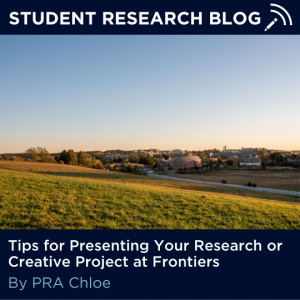 By Chloe Zampetti, Peer Research Ambassador
By Chloe Zampetti, Peer Research Ambassador
Your months of hard work and dedication to your research or creative project are finally summed up in a poster. First and foremost, congratulations on completing that huge step! It is now time to present your work!
It is both exciting and nerve wracking to be recognized at a poster conference or exhibition. I presented my own research project for the first time at the Fall Frontiers Undergraduate Research Poster Exhibition. To help you feel more prepared for your presentation, I am going to explain my experience so you know a bit more about what to expect, and then give you some tips and tricks on how to prepare your talk. Please note, Frontiers was not a competition-based poster exhibition, so if you are preparing for a competition, be sure to seek out additional resources along with this one.
I would first like to touch on the four variations of poster visitor that I encountered who, according to fellow researchers, seem to be universally experienced.
The Interested
This audience member will happily hear about your entire project and will likely have a few questions during and/or after your talk. These were some of my favorites because they showed that they were interested in my topic and gave me some confidence in my presenting abilities to carry to the next person.
The Curious
This poster visitor, while interested in hearing about your topic, only wants to know the main points of your project.
The Readers
This person may read your poster but may not want to engage with you. The best way I found to approach these audience members is to ask them if they have any questions. They’ll often reply with either their question or “no, I’m just looking.”
The Browsers
This person will glance at your poster as they walk by, perhaps even avoiding eye contact. Or maybe they won’t even look at your poster!
The audience at an academic event can be incredibly varied in background, so many attend conferences to see posters from a specific field or even just one specific poster. Don’t worry, people will absolutely come up to your poster and want to learn more about your work!
How do you cater your presentation to all these different audiences? Here is the process that worked for me:
- Decide on the story
Your poster is going to be your key to success. A good poster can tell your audience everything you want them to know without you having to say it. Your job as a presenter is to guide your poster visitors. Take some time to look at your poster and decide what “story” it tells, meaning what flow of information someone would follow when looking at your poster.
- Prepare your script
Go through each section of your poster and write out every word you would like to say about it. This will produce a script that is likely between 3-4 minutes in length. This is what you will use as the in-depth presentation of your poster for “The Interested” visitors.
- Reverse outlining
The focus of Step 2 is creating an all-inclusive explanation of your project. However, the Curious audience members and potentially the Readers won’t want to hear every detail of the project. So, since your 3-4 minute script represents each section of your poster, break it down into a one-sentence bullet point per section that tells the main idea. This will create a general skeleton for your talk. Use your reverse outline to create a new script, whether in writing or in your head. This time around, just focus on hitting those main points in between 1-2 minutes. This is the version of your talk you will give to the Curious, and perhaps the Readers, who approach your poster.
Presenting at Fall Frontiers was an incredibly rewarding experience for me. I hope these tips will help you feel excited and prepared for your presentation! Good luck!
Chloe is a senior majoring in Natural Resources with a concentration in Environmental Sustainability and Conservation Click here to learn more about Chloe.